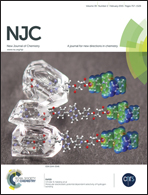Copper hydrotris(3,5-diphenylpyrazolyl)borate dithiocarbamates: mimicking green copper proteins†
Abstract
Three novel copper hydrotris(3,5-diphenylpyrazolyl)borate (TpPh2) dithiocarbamate complexes, [TpPh2Cu(dtc)] (dtc = S2CNEt21, S2CNBz22 and S2CN(CH2)43) have been prepared in a simple one pot reaction by sequential addition of KTpPh2 and Na(dtc) to CuCl2·2H2O. IR, UV-Vis and ESR spectroscopic studies suggest a mostly κ3 coordinated TpPh2 ligand, bidentate dithiocarbamate ligands and therefore, a five coordinate copper centre. Unusually, a κ3 to κ2 isomerisation of the TpPh2 ligand is found in solution in 3 and to a lesser extent in 1. The X-ray crystal structures reveal geometries intermediate between trigonal bipyramidal and square pyramidal depending on the steric bulk of the dithiocarbamate ligand and a long Cu–N bond resulting in an asymmetrically bound TpPh2 ligand. Electrochemical studies reveal quasi-reversible one-electron oxidation and reduction to Cu(I) with the reversibility and reduction potential strongly dependent on the dithiocarbamate. DFT calculations reveal a weakly antibonding Cu–S π* SOMO and a strongly antibonding Cu–S σ* LUMO consistent with the significant effect of the dithiocarbamate ligand on the electrochemical behaviour of these complexes.


 Please wait while we load your content...
Please wait while we load your content...